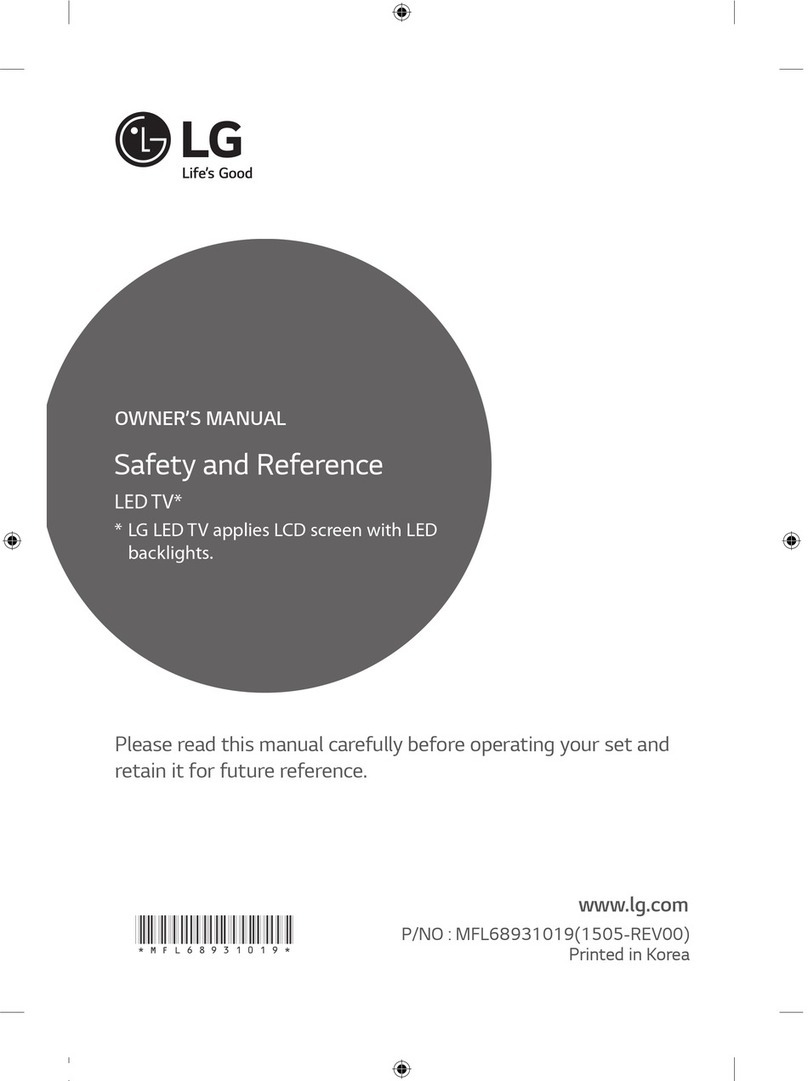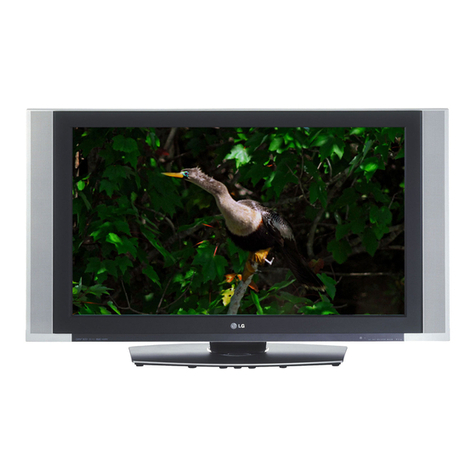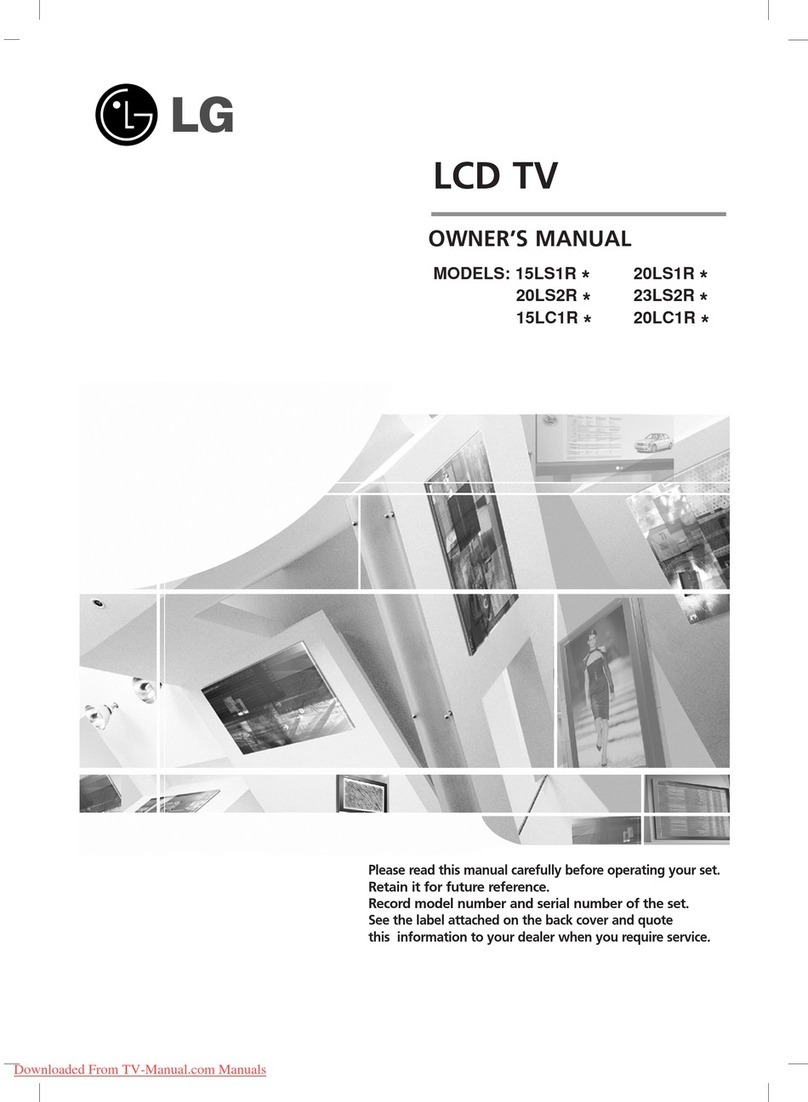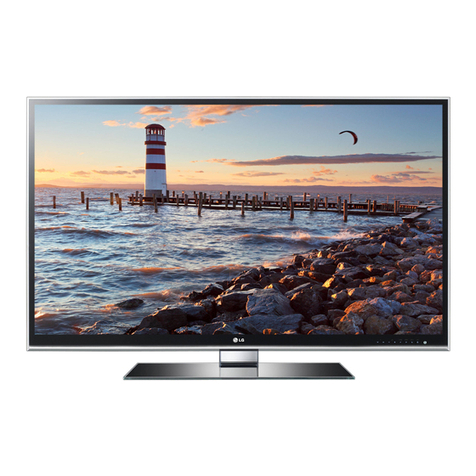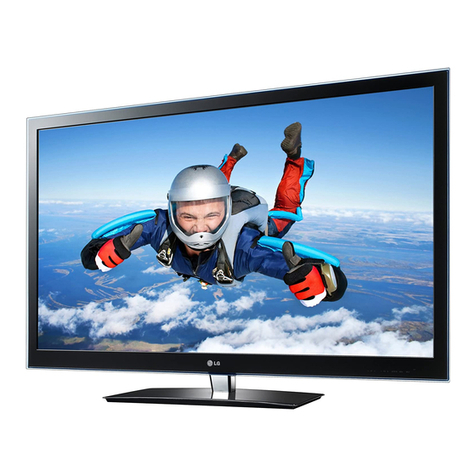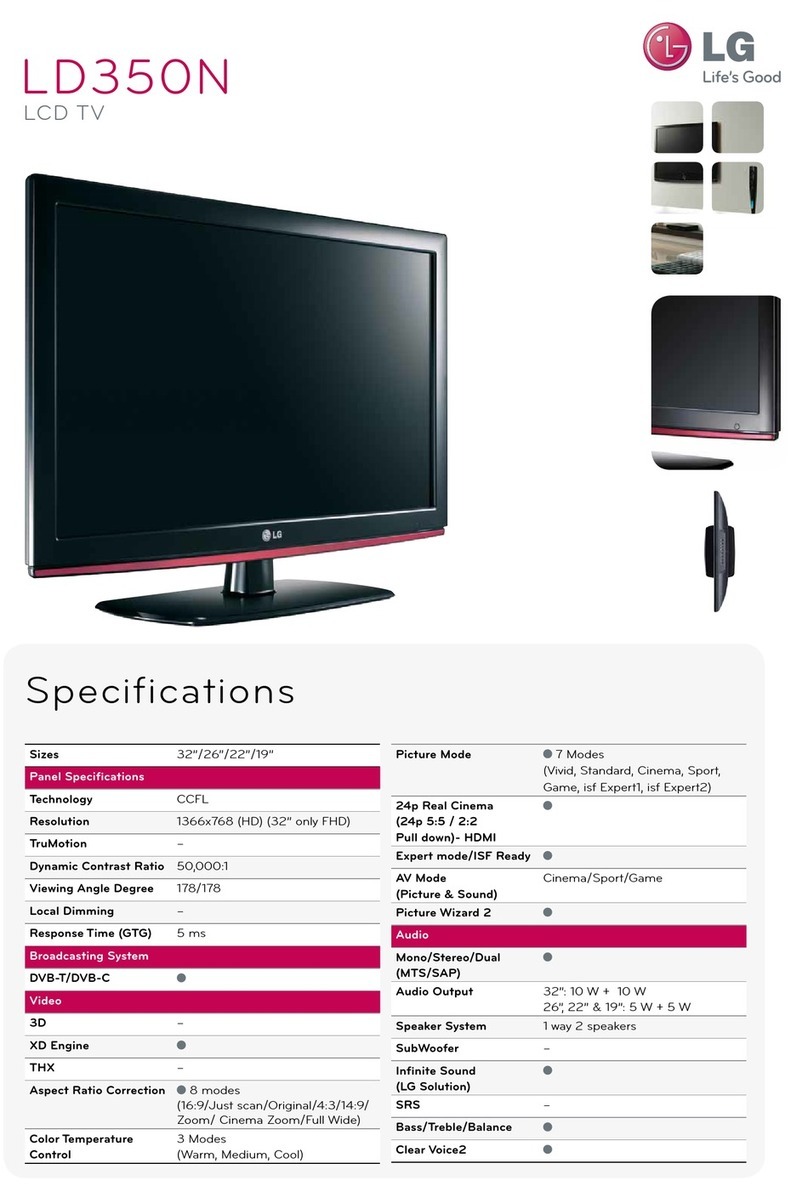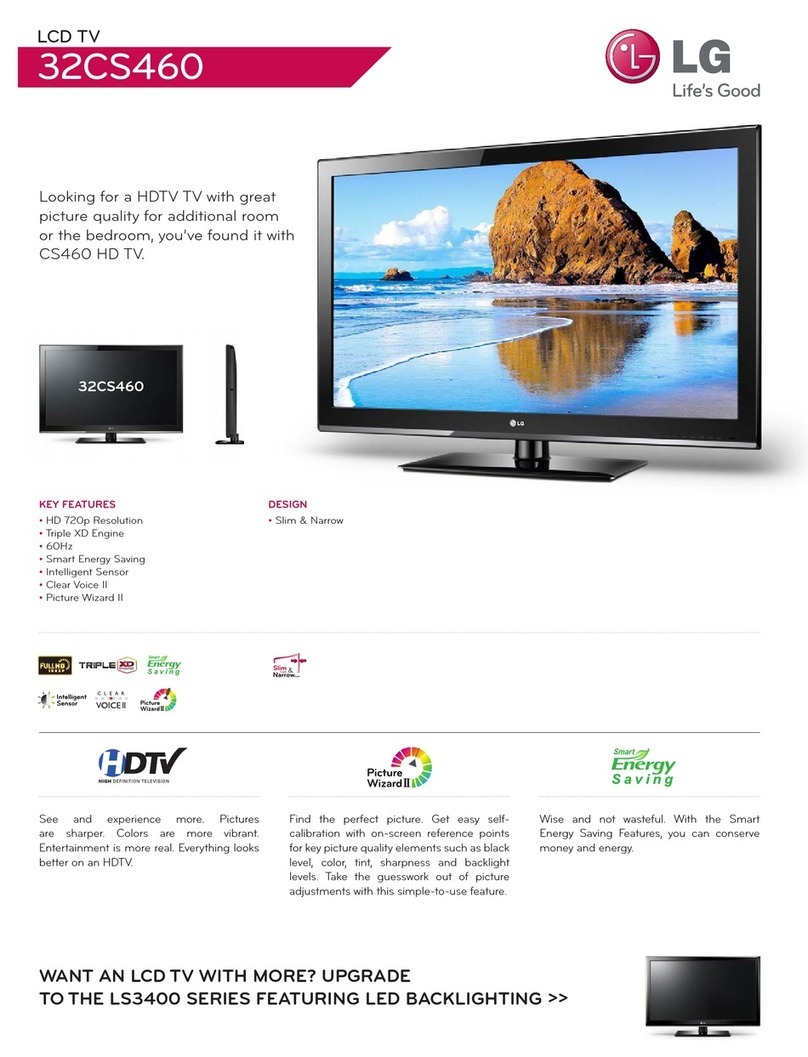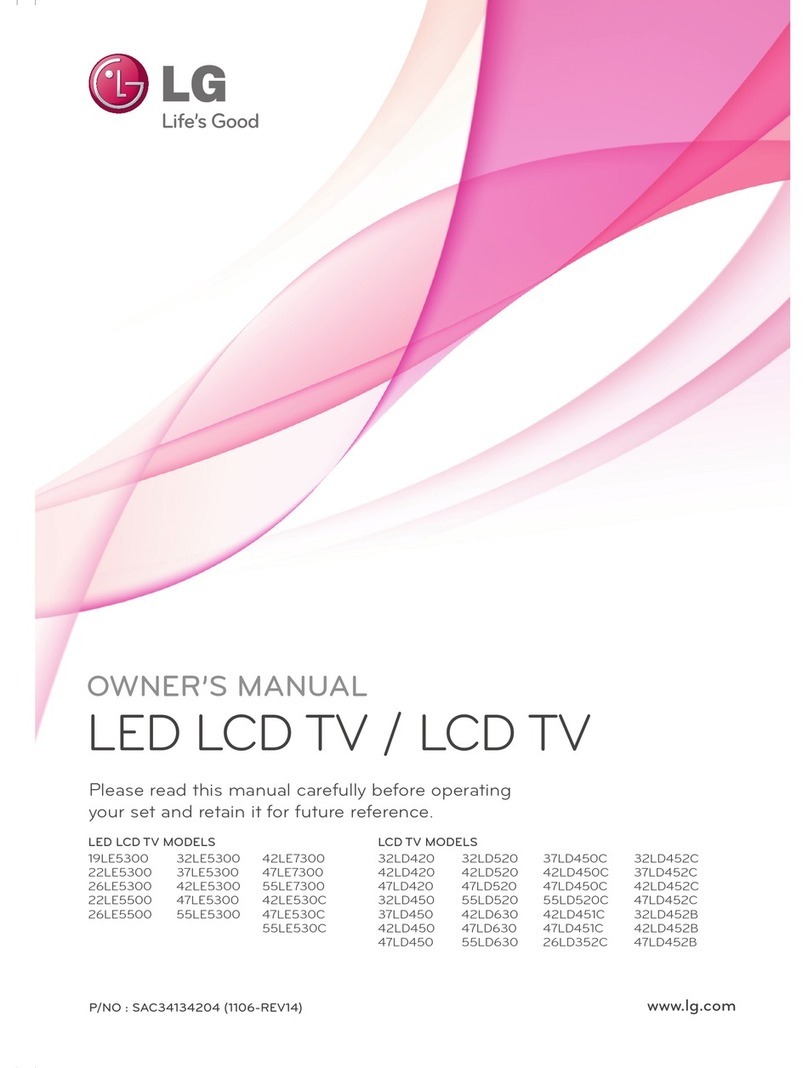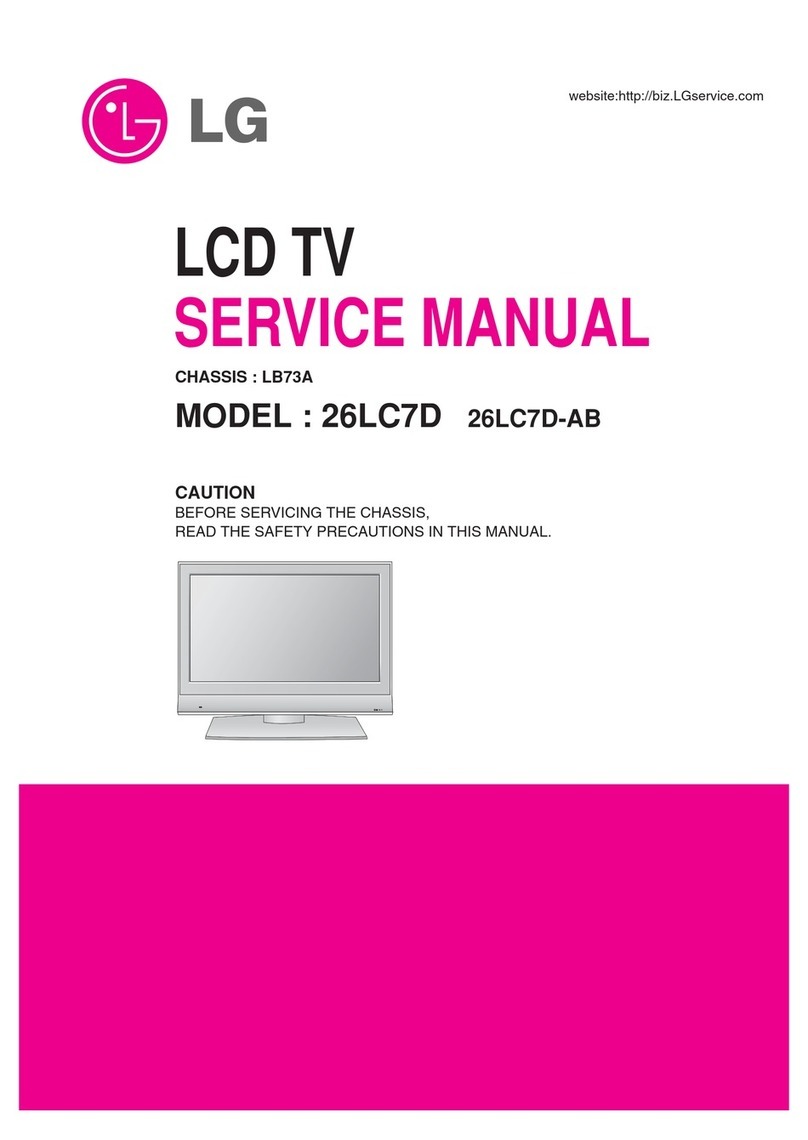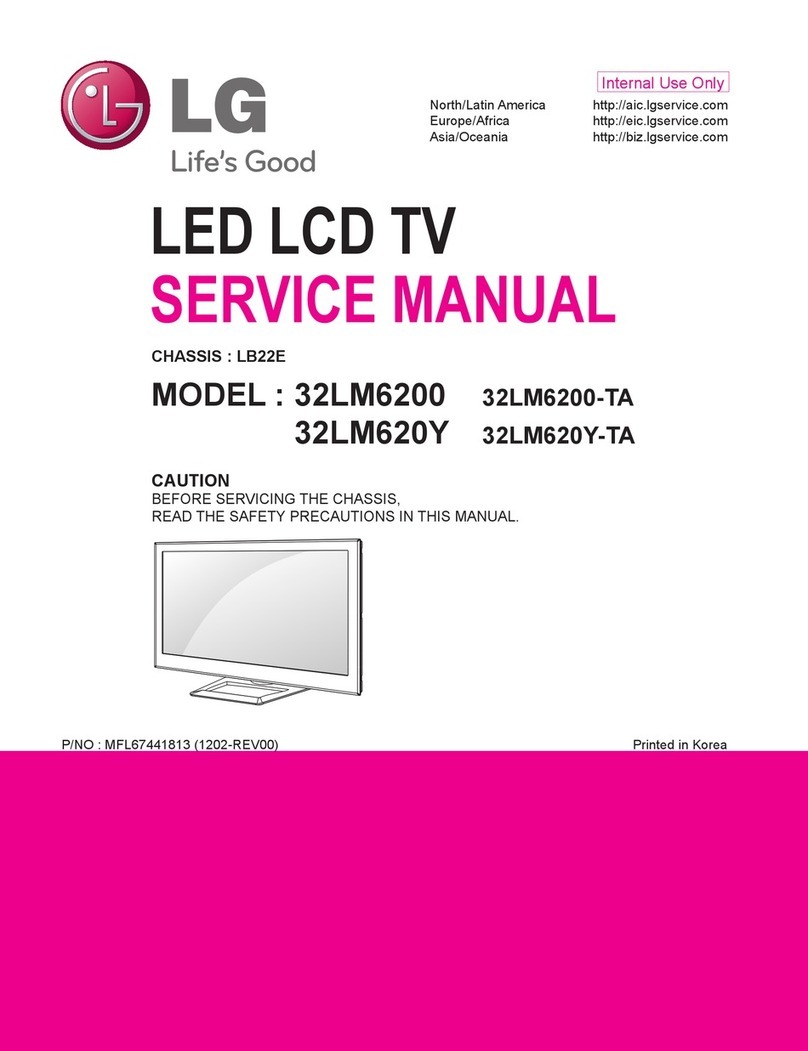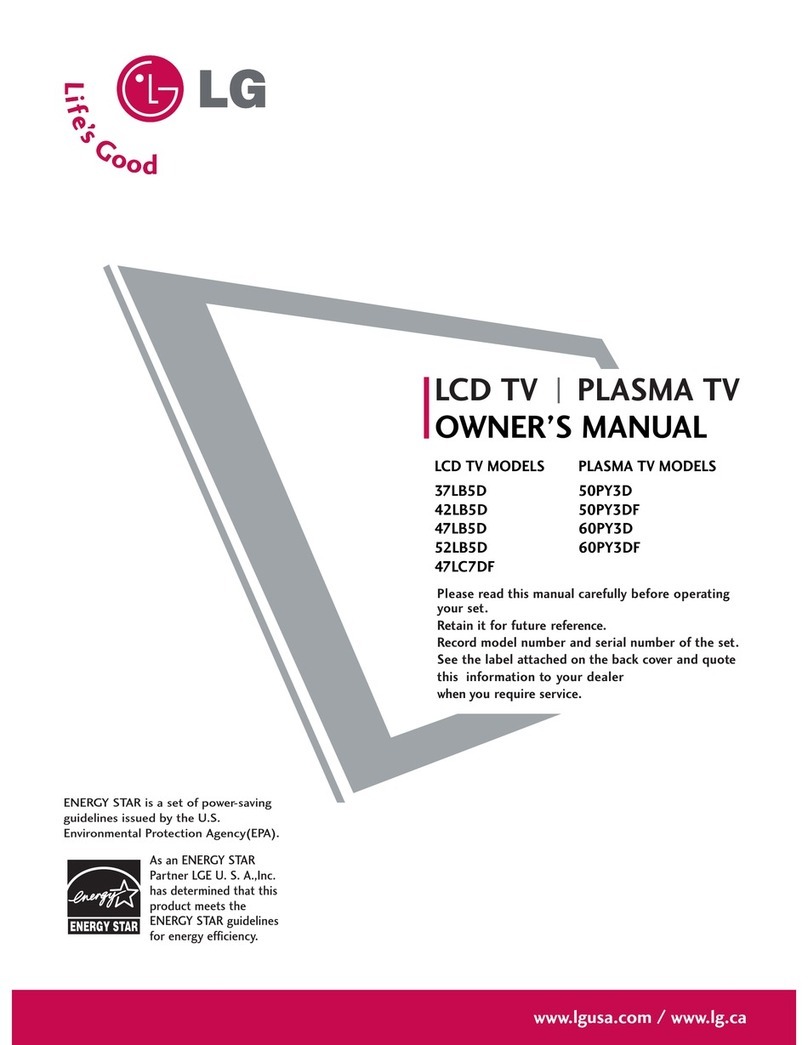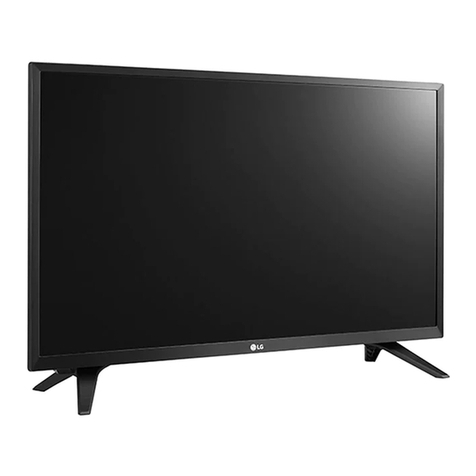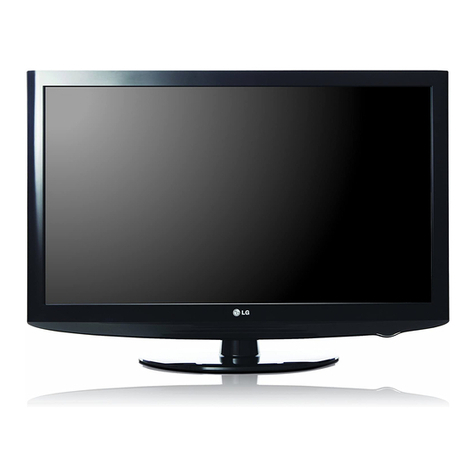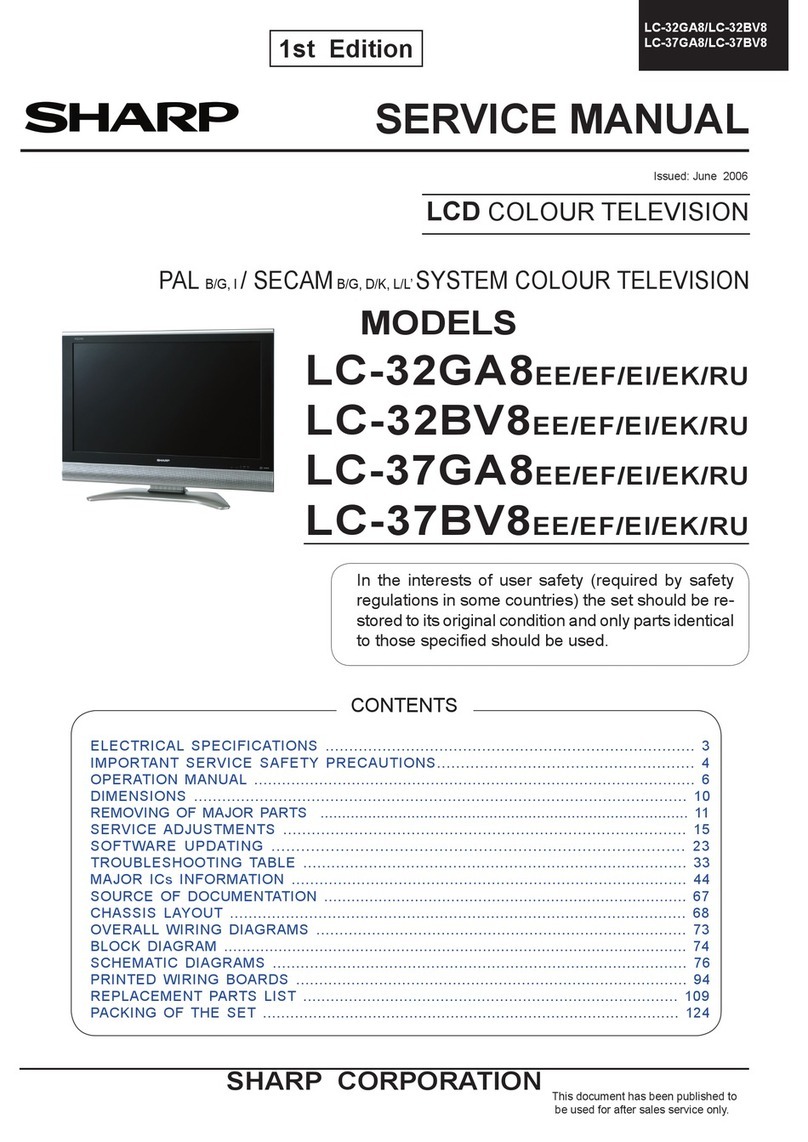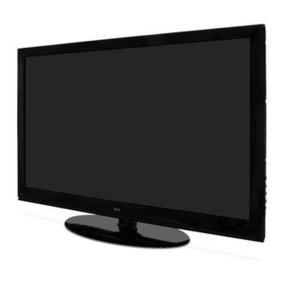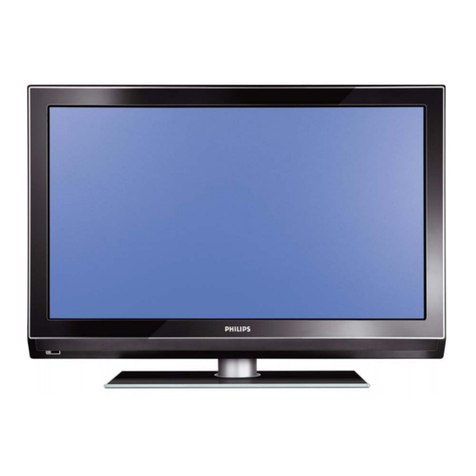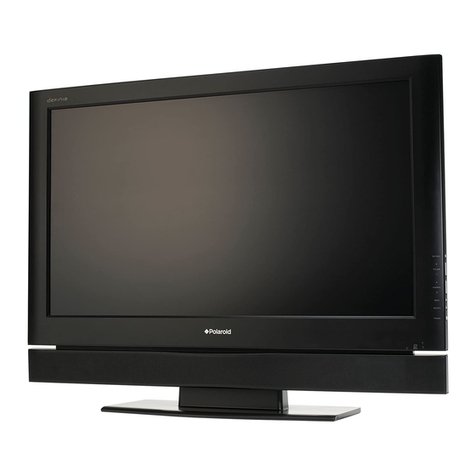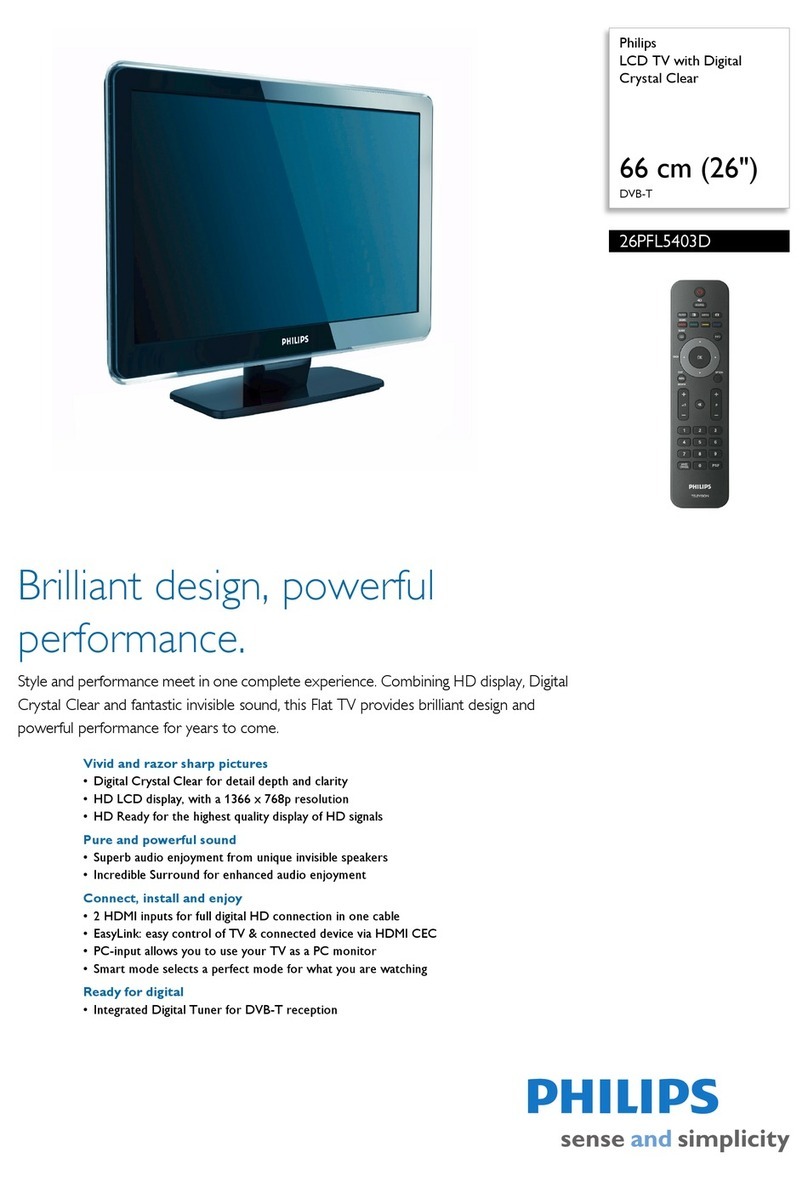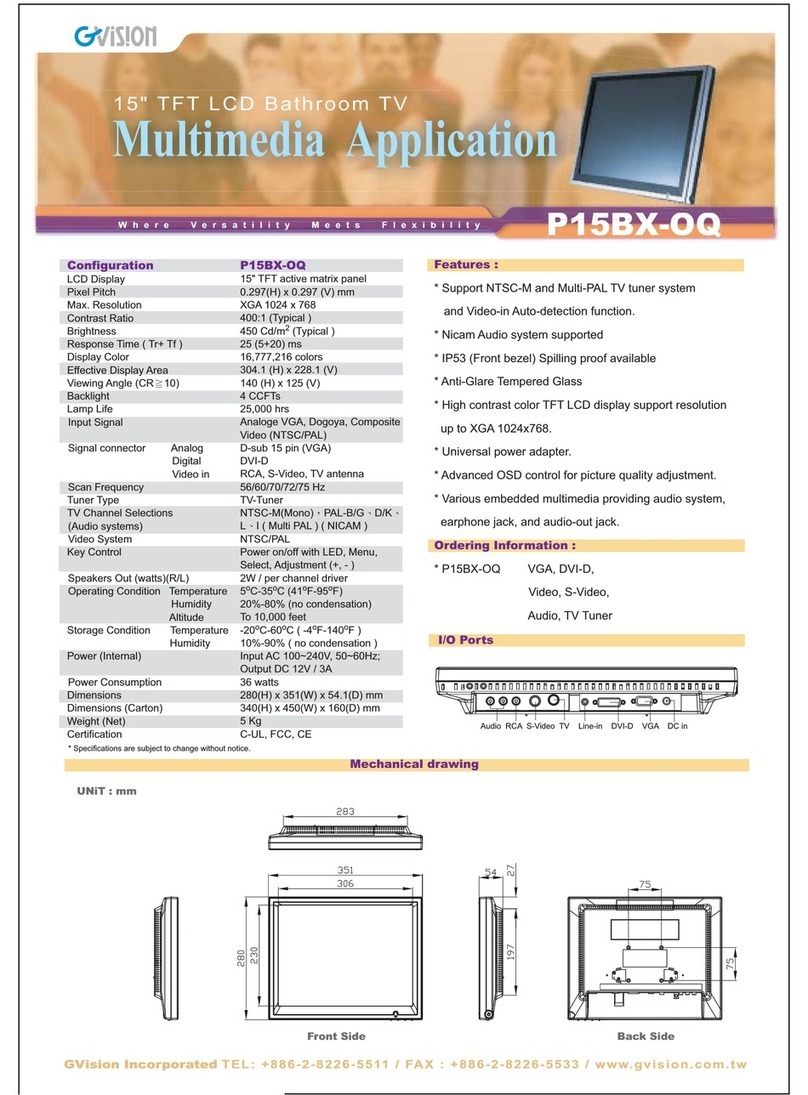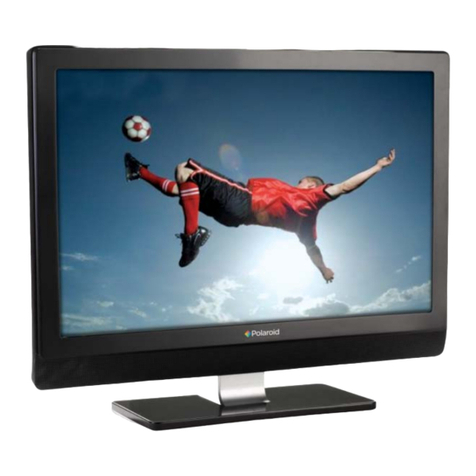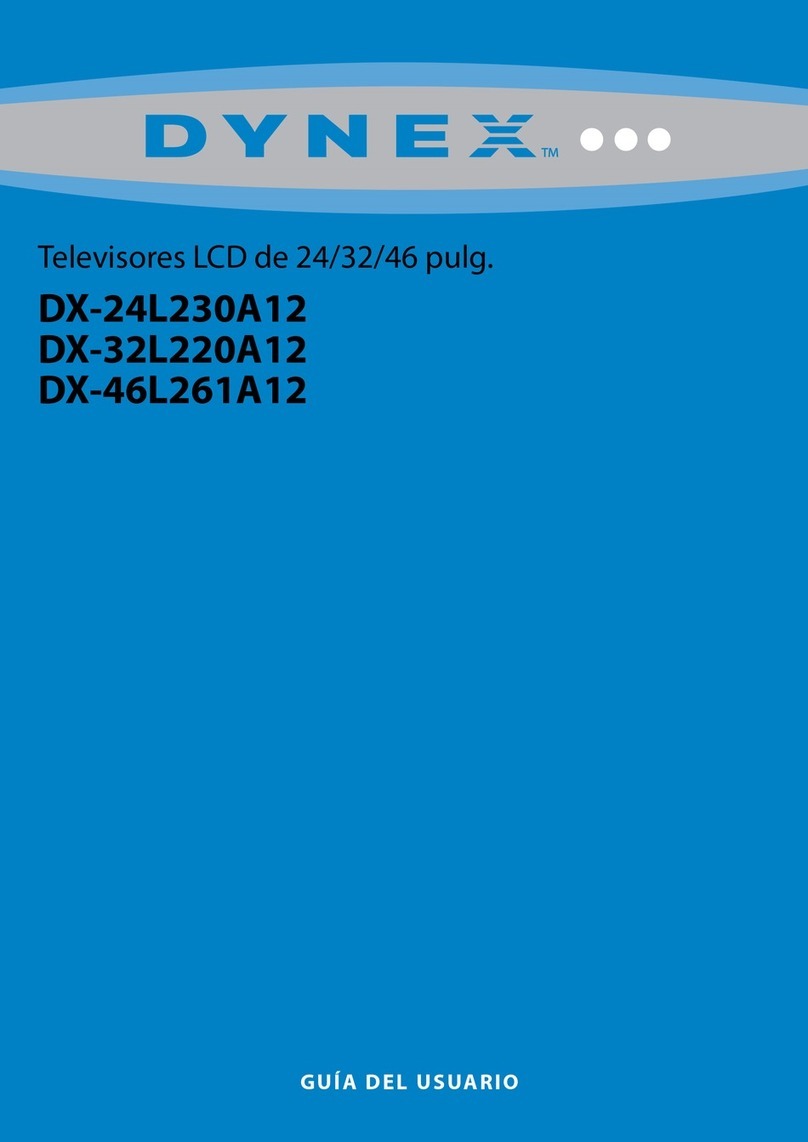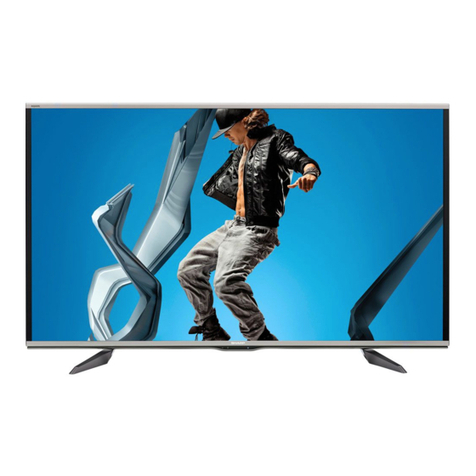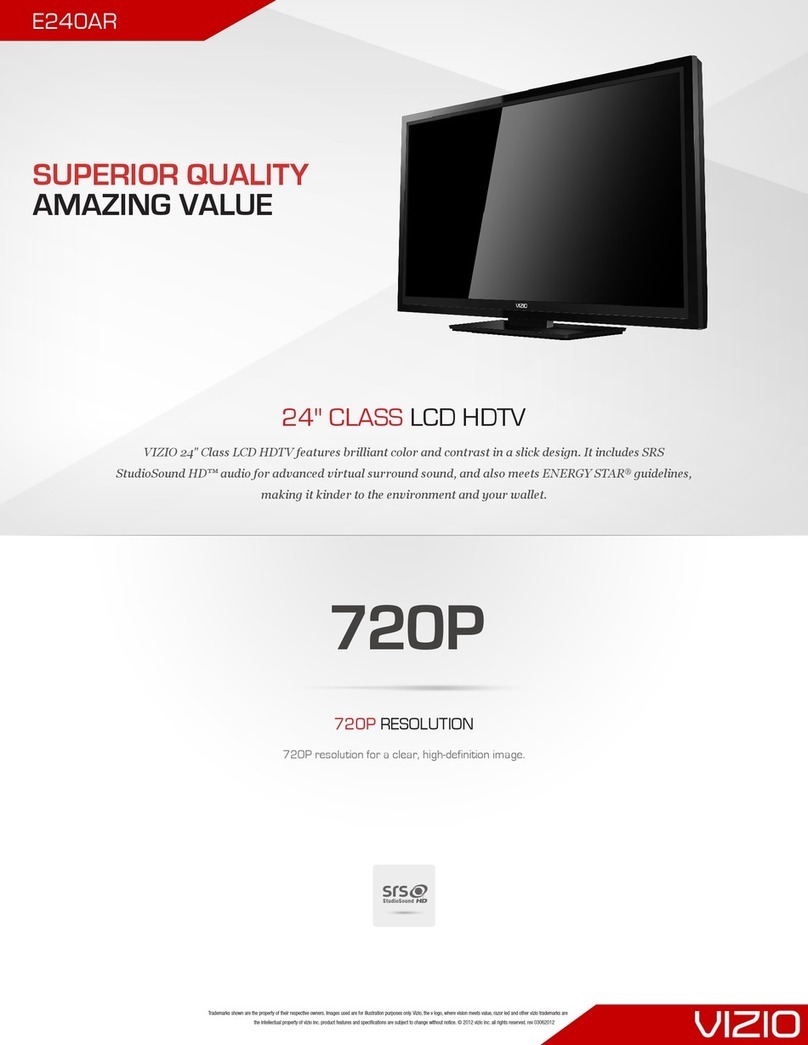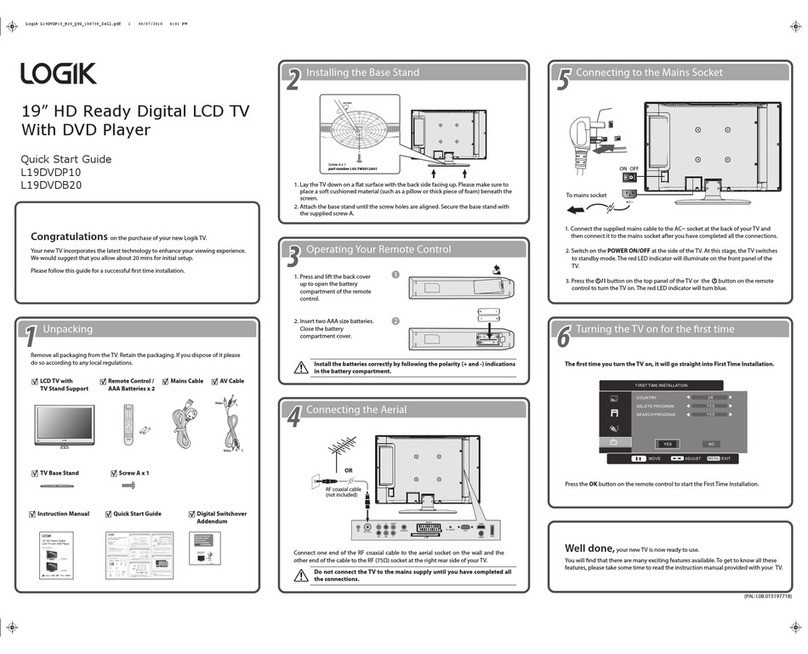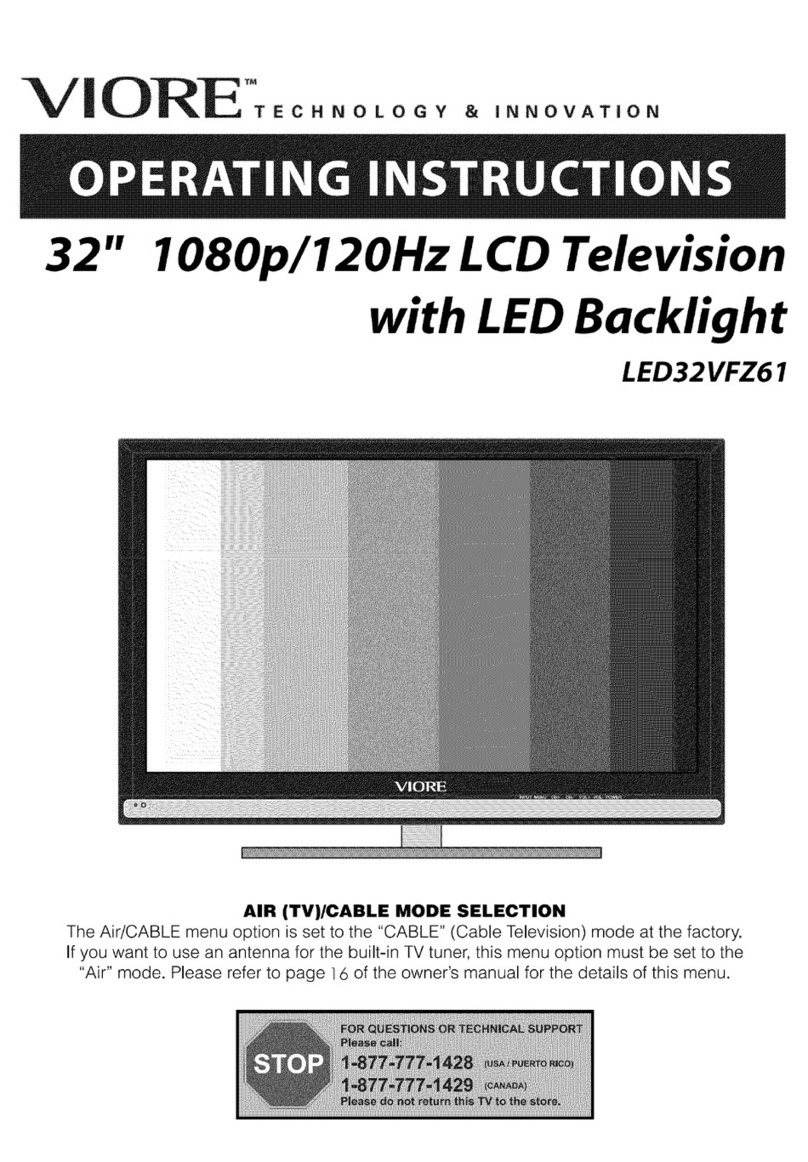LG 47LH30-UA User manual

LCD TV
SERVICE MANUAL
CAUTION
BEFORE SERVICING THE CHASSIS,
READ THE SAFETY PRECAUTIONS IN THIS MANUAL.
CHASSIS : LA92A
MODEL : 47LH30 47LH30-UA
North/Latin A erica http://aic.lgservice.co
Europe/Africa http://eic.lgservice.co
Asia/Oceania http://biz.lgservice.co
Internal Use Only

LGE Internal Use Only
Copyright LG Electronics. Inc. All right reserved.
Only for training and service purposes
C2009
- 2 -
CONTENTS
CONTENTS .............................................................................................. 2
PRODUCT SAFETY ..................................................................................3
SPECIFICATION........................................................................................6
ADJUSTMENT INSTRUCTION ...............................................................14
TROUBLE SHOOTING............................................................................17
BLOCK DIAGRAM...................................................................................23
EXPLODED VIEW .................................................................................. 24
SVC. SHEET ...............................................................................................

LGE Internal Use Only
Copyright LG Electronics. Inc. All right reserved.
Only for training and service purposes
C2009
- 3 -
SAFETY PRECAUTIONS
Many electrical and mechanical parts in this chassis have special safety-related characteristics. These parts are identified by in the
Schematic Diagram and Exploded View.
It is essential that these special safety parts should be replaced with the same components as recommended in this manual to prevent
Shock, Fire, or other Hazards.
Do not modify the original design without permission of manufacturer.
General Guidance
An isolation Transformer should always be used during the
servicing of a receiver whose chassis is not isolated from the AC
power line. Use a transformer of adequate power rating as this
protects the technician from accidents resulting in personal injury
from electrical shocks.
It will also protect the receiver and it's components from being
damaged by accidental shorts of the circuitry that may be
inadvertently introduced during the service operation.
If any fuse (or Fusible Resistor) in this TV receiver is blown,
replace it with the specified.
When replacing a high wattage resistor (Oxide Metal Film Resistor,
over 1W), keep the resistor 10mm away from PCB.
Keep wires away from high voltage or high temperature parts.
Before returning the receiver to the customer,
always perform an AC leakage current check on the exposed
metallic parts of the cabinet, such as antennas, terminals, etc., to
be sure the set is safe to operate without damage of electrical
shock.
Leakage Current Cold Check(Antenna Cold Check)
With the instrument AC plug removed from AC source, connect an
electrical jumper across the two AC plug prongs. Place the AC
switch in the on position, connect one lead of ohm-meter to the AC
plug prongs tied together and touch other ohm-meter lead in turn to
each exposed metallic parts such as antenna terminals, phone
jacks, etc.
If the exposed metallic part has a return path to the chassis, the
measured resistance should be between 1MΩand 5.2MΩ.
When the exposed metal has no return path to the chassis the
reading must be infinite.
An other abnormality exists that must be corrected before the
receiver is returned to the customer.
Leakage Current Hot Check (See below Figure)
Plug the AC cord directly into the AC outlet.
Do not use a line Isolation Transformer during this check.
Connect 1.5K/10watt resistor in parallel with a 0.15uF capacitor
between a known good earth ground (Water Pipe, Conduit, etc.)
and the exposed metallic parts.
Measure the AC voltage across the resistor using AC voltmeter
with 1000 ohms/volt or more sensitivity.
Reverse plug the AC cord into the AC outlet and repeat AC voltage
measurements for each exposed metallic part. Any voltage
measured must not exceed 0.75 volt RMS which is corresponds to
0.5mA.
In case any measurement is out of the limits specified, there is
possibility of shock hazard and the set must be checked and
repaired before it is returned to the customer.
Leakage Current Hot Check circuit
1.5 Kohm/10W
To Instrument’s
exposed
METALLIC PARTS
Good Earth Ground
such as WATER PIPE,
CONDUIT etc.
AC Volt-meter
When 25A is impressed between Earth and 2nd Ground
for 1 second, Resistance must be less than 0.1
*Base on Adjustment standard
IMPORTANT SAFETY NOTICE
0.15uF
Ω

- 4 - LGE Internal Use Only
Copyright LG Electronics. Inc. All right reserved.
Only for training and service purposes
C2009
CAUTION: Before servicing receivers covered by this service
manual and its supplements and addenda, read and follow the
SAFETY PRECAUTIONS on page 3 of this publication.
NOTE: If unforeseen circumstances create conflict between the
following servicing precautions and any of the safety precautions on
page 3 of this publication, always follow the safety precautions.
Remember: Safety First.
General Servicing Precautions
1. Always unplug the receiver AC power cord from the AC power
source before;
a. Removing or reinstalling any component, circuit board
module or any other receiver assembly.
b. Disconnecting or reconnecting any receiver electrical plug or
other electrical connection.
c. Connecting a test substitute in parallel with an electrolytic
capacitor in the receiver.
CAUTION: A wrong part substitution or incorrect polarity
installation of electrolytic capacitors may result in an
explosion hazard.
2. Test high voltage only by measuring it with an appropriate high
voltage meter or other voltage measuring device (DVM,
FETVOM, etc) equipped with a suitable high voltage probe.
Do not test high voltage by "drawing an arc".
3. Do not spray chemicals on or near this receiver or any of its
assemblies.
4. Unless specified otherwise in this service manual, clean
electrical contacts only by applying the following mixture to the
contacts with a pipe cleaner, cotton-tipped stick or comparable
non-abrasive applicator; 10% (by volume) Acetone and 90% (by
volume) isopropyl alcohol (90%-99% strength)
CAUTION: This is a flammable mixture.
Unless specified otherwise in this service manual, lubrication of
contacts in not required.
5. Do not defeat any plug/socket B+ voltage interlocks with which
receivers covered by this service manual might be equipped.
6. Do not apply AC power to this instrument and/or any of its
electrical assemblies unless all solid-state device heat sinks are
correctly installed.
7. Always connect the test receiver ground lead to the receiver
chassis ground before connecting the test receiver positive
lead.
Always remove the test receiver ground lead last.
8. Use with this receiver only the test fixtures specified in this
service manual.
CAUTION: Do not connect the test fixture ground strap to any
heat sink in this receiver.
Electrostatically Sensitive (ES) Devices
Some semiconductor (solid-state) devices can be damaged easily
by static electricity. Such components commonly are called
Electrostatically Sensitive (ES) Devices. Examples of typical ES
devices are integrated circuits and some field-effect transistors and
semiconductor "chip" components. The following techniques
should be used to help reduce the incidence of component
damage caused by static by static electricity.
1. Immediately before handling any semiconductor component or
semiconductor-equipped assembly, drain off any electrostatic
charge on your body by touching a known earth ground.
Alternatively, obtain and wear a commercially available
discharging wrist strap device, which should be removed to
prevent potential shock reasons prior to applying power to the
unit under test.
2. After removing an electrical assembly equipped with ES
devices, place the assembly on a conductive surface such as
aluminum foil, to prevent electrostatic charge buildup or
exposure of the assembly.
3. Use only a grounded-tip soldering iron to solder or unsolder ES
devices.
4. Use only an anti-static type solder removal device. Some solder
removal devices not classified as "anti-static" can generate
electrical charges sufficient to damage ES devices.
5. Do not use freon-propelled chemicals. These can generate
electrical charges sufficient to damage ES devices.
6. Do not remove a replacement ES device from its protective
package until immediately before you are ready to install it.
(Most replacement ES devices are packaged with leads
electrically shorted together by conductive foam, aluminum foil
or comparable conductive material).
7. Immediately before removing the protective material from the
leads of a replacement ES device, touch the protective material
to the chassis or circuit assembly into which the device will be
installed.
CAUTION: Be sure no power is applied to the chassis or circuit,
and observe all other safety precautions.
8. Minimize bodily motions when handling unpackaged
replacement ES devices. (Otherwise harmless motion such as
the brushing together of your clothes fabric or the lifting of your
foot from a carpeted floor can generate static electricity
sufficient to damage an ES device.)
General Soldering Guidelines
1. Use a grounded-tip, low-wattage soldering iron and appropriate
tip size and shape that will maintain tip temperature within the
range or 500°F to 600°F.
2. Use an appropriate gauge of RMA resin-core solder composed
of 60 parts tin/40 parts lead.
3. Keep the soldering iron tip clean and well tinned.
4. Thoroughly clean the surfaces to be soldered. Use a mall wire-
bristle (0.5 inch, or 1.25cm) brush with a metal handle.
Do not use freon-propelled spray-on cleaners.
5. Use the following unsoldering technique
a. Allow the soldering iron tip to reach normal temperature.
(500°F to 600°F)
b. Heat the component lead until the solder melts.
c. Quickly draw the melted solder with an anti-static, suction-
type solder removal device or with solder braid.
CAUTION: Work quickly to avoid overheating the circuit
board printed foil.
6. Use the following soldering technique.
a. Allow the soldering iron tip to reach a normal temperature
(500°F to 600°F)
b. First, hold the soldering iron tip and solder the strand against
the component lead until the solder melts.
c. Quickly move the soldering iron tip to the junction of the
component lead and the printed circuit foil, and hold it there
only until the solder flows onto and around both the
component lead and the foil.
CAUTION: Work quickly to avoid overheating the circuit
board printed foil.
d. Closely inspect the solder area and remove any excess or
splashed solder with a small wire-bristle brush.
SERVICING PRECAUTIONS

- 5 - LGE Internal Use Only
Copyright LG Electronics. Inc. All right reserved.
Only for training and service purposes
C2009
IC Remove/Replacement
Some chassis circuit boards have slotted holes (oblong) through
which the IC leads are inserted and then bent flat against the
circuit foil. When holes are the slotted type, the following technique
should be used to remove and replace the IC. When working with
boards using the familiar round hole, use the standard technique
as outlined in paragraphs 5 and 6 above.
Removal
1. Desolder and straighten each IC lead in one operation by gently
prying up on the lead with the soldering iron tip as the solder
melts.
2. Draw away the melted solder with an anti-static suction-type
solder removal device (or with solder braid) before removing the
IC.
Replacement
1. Carefully insert the replacement IC in the circuit board.
2. Carefully bend each IC lead against the circuit foil pad and
solder it.
3. Clean the soldered areas with a small wire-bristle brush.
(It is not necessary to reapply acrylic coating to the areas).
"Small-Signal" Discrete Transistor
Removal/Replacement
1. Remove the defective transistor by clipping its leads as close as
possible to the component body.
2. Bend into a "U" shape the end of each of three leads remaining
on the circuit board.
3. Bend into a "U" shape the replacement transistor leads.
4. Connect the replacement transistor leads to the corresponding
leads extending from the circuit board and crimp the "U" with
long nose pliers to insure metal to metal contact then solder
each connection.
Power Output, Transistor Device
Removal/Replacement
1. Heat and remove all solder from around the transistor leads.
2. Remove the heat sink mounting screw (if so equipped).
3. Carefully remove the transistor from the heat sink of the circuit
board.
4. Insert new transistor in the circuit board.
5. Solder each transistor lead, and clip off excess lead.
6. Replace heat sink.
Diode Removal/Replacement
1. Remove defective diode by clipping its leads as close as
possible to diode body.
2. Bend the two remaining leads perpendicular y to the circuit
board.
3. Observing diode polarity, wrap each lead of the new diode
around the corresponding lead on the circuit board.
4. Securely crimp each connection and solder it.
5. Inspect (on the circuit board copper side) the solder joints of
the two "original" leads. If they are not shiny, reheat them and if
necessary, apply additional solder.
Fuse and Conventional Resistor
Removal/Replacement
1. Clip each fuse or resistor lead at top of the circuit board hollow
stake.
2. Securely crimp the leads of replacement component around
notch at stake top.
3. Solder the connections.
CAUTION: Maintain original spacing between the replaced
component and adjacent components and the circuit board to
prevent excessive component temperatures.
Circuit Board Foil Repair
Excessive heat applied to the copper foil of any printed circuit
board will weaken the adhesive that bonds the foil to the circuit
board causing the foil to separate from or "lift-off" the board. The
following guidelines and procedures should be followed whenever
this condition is encountered.
At IC Connections
To repair a defective copper pattern at IC connections use the
following procedure to install a jumper wire on the copper pattern
side of the circuit board. (Use this technique only on IC
connections).
1. Carefully remove the damaged copper pattern with a sharp
knife. (Remove only as much copper as absolutely necessary).
2. carefully scratch away the solder resist and acrylic coating (if
used) from the end of the remaining copper pattern.
3. Bend a small "U" in one end of a small gauge jumper wire and
carefully crimp it around the IC pin. Solder the IC connection.
4. Route the jumper wire along the path of the out-away copper
pattern and let it overlap the previously scraped end of the good
copper pattern. Solder the overlapped area and clip off any
excess jumper wire.
At Other Connections
Use the following technique to repair the defective copper pattern
at connections other than IC Pins. This technique involves the
installation of a jumper wire on the component side of the circuit
board.
1. Remove the defective copper pattern with a sharp knife.
Remove at least 1/4 inch of copper, to ensure that a hazardous
condition will not exist if the jumper wire opens.
2. Trace along the copper pattern from both sides of the pattern
break and locate the nearest component that is directly
connected to the affected copper pattern.
3. Connect insulated 20-gauge jumper wire from the lead of the
nearest component on one side of the pattern break to the lead
of the nearest component on the other side.
Carefully crimp and solder the connections.
CAUTION: Be sure the insulated jumper wire is dressed so the
it does not touch components or sharp edges.

LGE Internal Use Only
Copyright LG Electronics. Inc. All right reserved.
Only for training and service purposes
C2009
- 6 -
SPECIFICATION
NOTE : Specifications and others are subject to change without notice for improvement
.
4. General specification
1. Application range
This specification is applied to the LCD TV used LA92A
chassis.
2. Requirement for Test
Each part is tested as below without special appointment.
1) Temperature : 25±5ºC (77±9ºF), CST : 40±5ºC
2) Relative Humidity : 65±10%
3)
Power Voltage : Standard input voltage(100~240V@50/60Hz)
* Standard Voltage of each products is marked by models.
4) Specification and performance of each parts are followed
each drawing and specification by part number in
accordance with BOM.
5) The receiver must be operated for about 5 minutes prior to
the adjustment.
3. Test method
1) Performance: LGE TV test method followed
2) Demanded other specification
- Safety: UL, CSA, IEC specification, CE
- EMC: FCC, ICES, IEC specification, CE
No Item Specification Remark
1. Receiving System 1) ATSC /NTSC-M
2. Available Channel 1) VHF : 02~13
2) UHF : 14~69
3) DTV : 02-69
4) CATV : 01~135
5) CADTV : 01~135
3. Input Voltage 1) AC 100 ~240V 50/60Hz Mark : 110V,60Hz
4. Market NORTH AMERICA,KOREA
5. Screen Size 47 inch Wide(1920 x 1080) FHD
6. Aspect Ratio 16:9
7. Tuning System FS
8. Module LC470WUE-SBB1 LGD(V4) 47LH30-UA
9. Operating Environment 1)Temp : 0 ~40 deg
2)Humidity : ~80 %
10. Storage Environment 1)Temp : -20 ~ 60 deg
2)Humidity : ~85 %

- 7 - LGE Internal Use Only
Copyright LG Electronics. Inc. All right reserved.
Only for training and service purposes
C2009
5. Safety and Regulation
No Item Min Typ Max Unit Remark
1. Force Stability –Incline Plane Tip Test 10 deg IEC60065
2. Force Stability –Level Tip Test 60 N
3. Isolation Gap,AC-AC 3 mm
4. Isolation Gap,AC-DC 3 mm
5. Isolation Gap,Primary <-> GND 3 mm
Isolation Gap,Primary <-> Secondary 6.0 mm
6. Power Consumption 270 W
-Audio signal : mono,100%modulation,
1/8Wof volume max
-Video signal :SMPTE Color bar signal
-Picture mode setting all max
7. Power Consumption,Stand by 0.9 1 W ST-BY power saving circuit
(Input voltage100V~240Vac/60Hz)
8. Power Consumption,Switch off 0.02 W
9. Energy Saving Off 100 % <Test Condition>
Minimum 65 75 85 % -Full white pattern(RF 6Ch)
Medium 43 53 63 % -Picture Mode : Vivid
Maximum 17 27 37 % -Sound: 1/8W
Screen Off 15 %
10. OPC Black luminance 54 60 66 % 150 Gray Input <Test Condition>
difference of OPC
-white No Luminance
Vivid mode,4% window white pattern
on/off mode difference
*255 Gray Input Case:white/black
No Luminance difference
11. Dielectric Voltage GND 1500 V/min at 100mA IEC60065
SIGNAL 3000 V/min at 100mA
12. Isolation Resistance 4 ∞MΩ
13. Leakage Current 0.35 mA rms
14. Sharp Edge None
15. UL Compliance Safety UL1492
EMC FCC Class B
16. CSA Compliance Safety CSA C22.2.No.1
EMC IC

- 8 - LGE Internal Use Only
Copyright LG Electronics. Inc. All right reserved.
Only for training and service purposes
C2009
6. Chrominance & Luminance Specification
6.1 Module Optical Specification.
6.1.1 Color Temperature measure standard specification
1) In non-impressed condition, measure White Balance displayable as much as possible LCD module.
2) Measuring instrument: CA-210 or a sort of Color Analyzer.
3) Pattern Generator : VG-828 or a sort of digital pattern generator (216 Gray)
4) Measure condition
•Test pattern: 85% Full White pattern
•SET condition: Contrast & Brightness Level 100%
•Environment condition : Dark room in the non outside light
•Video menu option condition
6.1.2 Max Luminance & Contrast measure standard specification
1) In non-impressed condition, measure peak brightness displayable as much as possible LCD module.
2) Measuring instrument:CA-210 or a sort of Color Analyzer.
3) Pattern Generator :VG-828 or a sort of digital pattern generator (displayable Full White & 1/25 White Window pattern)
4) Measure condition
•Test pattern: in center,1/5(H)*1/5(V) of Window Pattern (white pattern in non-impressed condition)
•SET condition : Contrast & Brightness Level 100%
•Environment condition: Dark room in the non outside light
•Video menu option condition
Signal Picture Mode Dynamic Contrast Dynamic Color Black Level OPC
RF NTSC-M Vivid Off Off Low Off
AV NTSC-J Vivid Off Off High Off
Component 720P Vivid Off Off High Off
RGB 1024x768 Vivid NA NA NA NA
HDMI DTV 720P Vivid Off Off Low Off
No. Item Specification Min. Typ. Max. Remark
1. Max Luminance Modele 400 500 cd/m2
(Center1-point/ Ful white pattern)
2. Luminance uniformity Luminance 77
3. Contrast Ratio 1000: 1 1400: 1
30000:1(DCR) 50000:1(DCR)
WX Typ 0.279 Typ
White WY -0.03 0.292 +0.03
4. Color Coordinates Xr 0.636
RED Yr 0.334
Xg 0.290
Green Yg 0.608
Xb 0.145
Blue Yb 0.064
5. Color Temperatue Cool 0.274 0.276 0.278 85% Full white pattern
0.281 0.283 0.285 **The W/B Tolerance is
Medium 0.283 0.285 0.287 ± 0.015 for Adjustment
0.291 0.293 0.295
Warm 0.311 0.313 0.315
0.327 0.329 0.331

5) Measurement
•Do heat-run LCD module at 5minutes in normal temperature (25°C) by using full white pattern of 15% signal level(38 gray level).
•Impress test pattern signal in 1/5(H)*1/5(V) White Window of 100% (255Gray Level)
•measure 3 times brightness of central white window, and mark peak brightness in max brightness degree
•measure the same condition in video signal /RGB signal.
6.1.3 Luminance uniformity measure specification
1) Impress 100 % (255Gray Level) full white pattern at the same peak brightness measurement.
2) Measure average brightness in 9 points.
6.1.4 Contrast ratio measure specification
1) Test display signal : 30*30 dots White Window signal & all Black Raster signal
2) Dark room measure condition: Using touch type Color analyzer CA-210 Dark room in the non outside light
3) Bright room measure condition: In bright room of 150Lx illumination in the panel surface, locate a source of light on the above
45°of the panel surface.
4) Measure method
•In standard test condition, Impress 30*30 dots White Window Pattern signal .
Measure center peak brightness degree Lw of white window
•Impress black Raster signal as contrast ratio measurement signal.
Measure black brightness degree Lb of PDP central
Calculate the following numerical formula.
Contrast ratio = Lw / Lb
* If it does not use Prior measurement, use generally simple test measurement. The Correct measure specification is followed by
IEC61988-2/CD, JAPAN EIAJ-2710
- 9 - LGE Internal Use Only
Copyright LG Electronics. Inc. All right reserved.
Only for training and service purposes
C2009
7. Component input (Y, CB/PB, CR/PR)
No Specification Remark
Resolution H-freq(kHz) V-freq(Hz) Pixel Clock(MHz)
1. 720*480 15.73 60 13.5135 SDTV ,DVD 480I
2. 720*480 15.73 59.94 13.5 SDTV ,DVD 480I
3. 720*480 31.50 60 27.027 SDTV 480P
4. 720*480 31.47 59.94 27.0 SDTV 480P
5. 1280*720 45.00 60.00 74.25 HDTV 720P
6. 1280*720 44.96 59.94 74.176 HDTV 720P
7. 1920*1080 33.75 60.00 74.25 HDTV 1080I
8. 1920*1080 33.72 59.94 74.176 HDTV 1080I
9. 1920*1080 67.500 60 148.50 HDTV 1080P
10. 1920*1080 67.432 59.94 148.352 HDTV 1080P
11. 1920*1080 27.000 24.000 74.25 HDTV 1080P
12. 1920*1080 26.97 23.976 74.176 HDTV 1080P
13. 1920*1080 33.75 30.000 74.25 HDTV 1080P
14. 1920*1080 33.71 29.97 74.176 HDTV 1080P
147
258
3 6 9
Signal Picture Mode Dynamic Contrast Dynamic Color Black Level OPC
RF NTSC-M Vivid High High Low Off
AV NTSC-J Vivid High High High Off
Component 720P Vivid High High High Off
RGB 1024x768 Vivid NA NA NA NA
HDMI DTV 720P Vivid High High Low Off

- 10 - LGE Internal Use Only
Copyright LG Electronics. Inc. All right reserved.
Only for training and service purposes
C2009
No Specification Proposed
Resolution H-freq(kHz) V-freq(Hz) Pixel Clock(MHz) DDC
1. 640*350 31.468 70.09 25.17 EGA X
2. 720*400 31.469 70.08 28.32 DOS O
3. 640*480 31.469 59.9 25.17 VESA(VGA) O
4. 800*600 35.156 56.25 36.00 VESA(SVGA) O
5. 800*600 37.879 60.31 40.00 VESA(SVGA) O
6. 1024*768 48.363 60.00 65.00 VESA(XGA) O
7. 1280*768 47.776 59.870 79.5 CVT(WXGA) X
8. 1360*768 47.712 60.015 85.50 VESA (WXGA) X
9. 1366*768 47.13 59.65 72 X
10. 1280*1024 63.981 60.020 108.00 VESA (SXGA) O
11. 1600*1200 75.00 60.00 162 VESA (UXGA) O
12. 1920*1080 66.587 59.934 138.5 HDTV 1080P O
8. RGB
8.1 PC Input
9. HDMI Input (PC/DTV)
9.1 PC Mode
No Resolution H-freq(kHz) V-freq.(Hz) Pixel clock(MHz) Proposed DDC
1 640*350 31.468 70.09 25.17 EGA X
2 720*400 31.469 70.08 28.32 DOS O
3 640*480 31.469 59.94 25.17 VESA(VGA) O
4 800*600 35.156 56.25 36.00 VESA(SVGA) O
5 800*600 37.879 60.31 40.00 VESA(SVGA) O
6 1024*768 48.363 60.00 65.00 VESA(XGA) O
7 1280*768 47.776 59.870 79.5 CVT(WXGA) O
8 1360*768 47.712 60.015 85.50 VESA (WXGA) O
9 1280*1024 63.981 60.020 108.00 VESA (SXGA) O
10 1600*1200 75.00 60.00 162 VESA (UXGA) O
11 1920*1080 67.5 60 148.5 HDTV 1080P O
8.2 DTV Mode
No Resolution H-freq(kHz) V-freq.(Hz) Pixel clock(MHz) Proposed Remark
1 720*480 31.50 60 27.027 SDTV 480P
2 720*480 31.47 59.94 27.00 SDTV 480P
3 1280*720 45.00 60.00 74.25 HDTV 720P
4 1280*720 44.96 59.94 74.176 HDTV 720P
5 1920*1080 33.75 60.00 74.25 HDTV 1080I
6 1920*1080 33.72 59.94 74.176 HDTV 1080I
7 1920*1080 67.500 60 148.50 HDTV 1080P
8 1920*1080 67.432 59.939 148.352 HDTV 1080P
9 1920*1080 27.000 24.000 74.25 HDTV 1080P
10 1920*1080 26.97 23.976 74.176 HDTV 1080P
11 1920*1080 33.75 30.000 74.25 HDTV 1080P
12 1920*1080 33.71 29.97 74.176 HDTV 1080P

- 11 - LGE Internal Use Only
Copyright LG Electronics. Inc. All right reserved.
Only for training and service purposes
C2009
10. EDID(The Extended Display Identification Data)
/ DDC(Display Data Channel) Download.
10.1 Over view
It is a VESA regulation. A PC or a MNT will display an optimal resolution through information sharing without any necessity of
user input. It is a realization of “Plug and Play”.
10.2 Equipment
•Since embedded EDID data is used, EDID download JIG, HDMI cable and D-sub cable are not need.
•Adjust remocon
10.3 Download method
1) Press Adj. key on the Adj. R/C,
2) Select EDID D/L menu.
3) By pressing Enter key, EDID download will begin
4) If Download is successful, OK is display, but If Download is failure, NG is displayed.
5) If Download is failure, Re-try download.
* Caution) When EDID Download, must remove RGB/HDMI Cable.
•RGB [C/S: B7FF]
EDID Block 0, table=
•HDMI I [C/S: XXBA]
EDID Block 0, table=
EDID Block 1, table=
0 1 2 3 4 5 6 7 8 9 A B C D E F
0 00 FF FF FF FF FF FF 00 1E 6D 02 00 01 01 01 01
10 XX XX 01 03 68 73 41 78 0A CF 74 A3 57 4C B0 23
20 09 48 4C A1 08 00 A9 40 81 80 61 40 45 40 31 40
30 01 01 01 01 01 01 02 3A 80 18 71 38 2D 40 58 2C
40 45 00 7E 8A 42 00 00 1E 01 1D 00 72 51 D0 1E 20
50 6E 28 55 00 7E 8A 42 00 00 1E 00 00 00 FD 00 39
60 3F 1F 52 10 00 0A 20 20 20 20 20 20 00 00 00 FC
70 00 4C 47 20 54 56 0A 20 20 20 20 20 20 20 00 XX
0 1 2 3 4 5 6 7 8 9 A B C D E F
0 00 FF FF FF FF FF FF 00 1E 6D 02 00 01 01 01 01
10 XX XX 01 03 80 73 41 78 0A CF 74 A3 57 4C B0 23
20 09 48 4C A1 08 00 A9 40 81 80 61 40 45 40 31 40
30 01 01 01 01 01 01 02 3A 80 18 71 38 2D 40 58 2C
40 45 00 7E 8A 42 00 00 1E 01 1D 00 72 51 D0 1E 20
50 6E 28 55 00 7E 8A 42 00 00 1E 00 00 00 FD 00 39
60 3F 1F 52 10 00 0A 20 20 20 20 20 20 00 00 00 FC
70 00 4C 47 20 54 56 0A 20 20 20 20 20 20 20 01 XX
0 1 2 3 4 5 6 7 8 9 A B C D E F
0 02 03 1F F1 47 90 22 20 05 04 03 02 26 15 07 50
10 09 07 07 6B 03 0C 00 10 00 B8 2D E3 05 03 01 02
20 3A 80 18 71 38 2D 40 58 2C 04 05 7E 8A 42 00 00
30 1E 01 1D 80 18 71 1C 16 20 58 2C 25 00 7E 8A 42
40 00 00 9E 01 1D 00 72 51 D0 1E 20 6E 28 55 00 7E
50 8A 42 00 00 1E 8C 0A D0 8A 20 E0 2D 10 10 3E 96
60 00 7E 8A 42 00 00 18 26 36 80 A0 70 38 1B 40 30
70 20 25 00 7E 8A 42 00 00 1A 00 00 00 00 00 00 CA

LGE Internal Use Only
Copyright LG Electronics. Inc. All right reserved.
Only for training and service purposes
C2009
- 12 -
•HDMI II [C/S: XXAA]
EDID Block 0, table =
EDID Block 1, table =
•HDMI III [C/S: XX9A]
EDID Block 0, table =
EDID Block 1, table =
0 1 2 3 4 5 6 7 8 9 A B C D E F
0 00 FF FF FF FF FF FF 00 1E 6D 02 00 01 01 01 01
10 XX XX 01 03 80 73 41 78 0A CF 74 A3 57 4C B0 23
20 09 48 4C A1 08 00 A9 40 81 80 61 40 45 40 31 40
30 01 01 01 01 01 01 02 3A 80 18 71 38 2D 40 58 2C
40 45 00 7E 8A 42 00 00 1E 01 1D 00 72 51 D0 1E 20
50 6E 28 55 00 7E 8A 42 00 00 1E 00 00 00 FD 00 39
60 3F 1F 52 10 00 0A 20 20 20 20 20 20 00 00 00 FC
70 00 4C 47 20 54 56 0A 20 20 20 20 20 20 20 01 XX
0 1 2 3 4 5 6 7 8 9 A B C D E F
0 02 03 1F F1 47 90 22 20 05 04 03 02 26 15 07 50
10 09 07 07 6B 03 0C 00 20 00 B8 2D E3 05 03 01 02
20 3A 80 18 71 38 2D 40 58 2C 04 05 7E 8A 42 00 00
30 1E 01 1D 80 18 71 1C 16 20 58 2C 25 00 7E 8A 42
40 00 00 9E 01 1D 00 72 51 D0 1E 20 6E 28 55 00 7E
50 8A 42 00 00 1E 8C 0A D0 8A 20 E0 2D 10 10 3E 96
60 00 7E 8A 42 00 00 18 26 36 80 A0 70 38 1B 40 30
70 20 25 00 7E 8A 42 00 00 1A 00 00 00 00 00 00 BA
0 1 2 3 4 5 6 7 8 9 A B C D E F
0 00 FF FF FF FF FF FF 00 1E 6D 02 00 01 01 01 01
10 XX XX 01 03 80 73 41 78 0A CF 74 A3 57 4C B0 23
20 09 48 4C A1 08 00 A9 40 81 80 61 40 45 40 31 40
30 01 01 01 01 01 01 02 3A 80 18 71 38 2D 40 58 2C
40 45 00 7E 8A 42 00 00 1E 01 1D 00 72 51 D0 1E 20
50 6E 28 55 00 7E 8A 42 00 00 1E 00 00 00 FD 00 39
60 3F 1F 52 10 00 0A 20 20 20 20 20 20 00 00 00 FC
70 00 4C 47 20 54 56 0A 20 20 20 20 20 20 20 01 XX
0 1 2 3 4 5 6 7 8 9 A B C D E F
0 02 03 1F F1 47 90 22 20 05 04 03 02 26 15 07 50
10 09 07 07 6B 03 0C 00 20 00 B8 2D E3 05 03 01 02
20 3A 80 18 71 38 2D 40 58 2C 04 05 7E 8A 42 00 00
30 1E 01 1D 80 18 71 1C 16 20 58 2C 25 00 7E 8A 42
40 00 00 9E 01 1D 00 72 51 D0 1E 20 6E 28 55 00 7E
50 8A 42 00 00 1E 8C 0A D0 8A 20 E0 2D 10 10 3E 96
60 00 7E 8A 42 00 00 18 26 36 80 A0 70 38 1B 40 30
70 20 25 00 7E 8A 42 00 00 1A 00 00 00 00 00 00 AA

- 13 - LGE Internal Use Only
Copyright LG Electronics. Inc. All right reserved.
Only for training and service purposes
C2009
12. POWER
No Item Min Typ Max Unit Remark
1. Power On/Off 10000 times
2. DC Voltage Inverter Voltage 21.6 24 26.4 V
Logic Voltage(Vcc) 4.7 5 5.3 V
Sound Amp Vcc 14.0 15.0 16.0 V 14~25V
19 20 21 V 20V: Lips
23 24 25 V 24V: Normal PSU
Micom B+ 3.25 3.4 3.55 V
Tuner 5V 4.75 5.0 5.25 V
VSC Vcc 24V 23.0 24.0 22.0 V Normal PSU
20V 19.0 20.0 21.0 V Lips
12V 11.0 12.0 13.0 V
5V 4.5 5.0 5.5 V Inside Temp.Under 20deg.
No operation 0 0.5 1 V
3. AC Power Shut Down Voltage 90 264 V Wide Range PSU
13. Mechanical Specification.
No Item Content Unit
1 Protrusion Satisfy appearance inspection LG(51)G2-2001
2 Appearance quality Satisfy appearance inspection LG(51)G1-1030
3 Print specification Distinguish printed matter at a distance of 40cm
4 Product Before Packing 1140.6 (W)X 723 (H)X 99 (D) mm Without Stand
Dimension After Packing 1250 (W)X 885 (H)X 245 (D) mm Without Stand
5 Product Only SET 21.9 Kg Without Stand
Weight With BOX 24.5 Kg Without Stand
6 Stand Ass’y SWIVEL (±)20 degree Fixed Stand
11. DIGITAL PART
No Item Standard Unit Remark
1. VSB Receiving CH.2 ~69CH
1 ~135CH(CATV)
1 ~135CH(CADTV))
2. Video Resolution ATSC 18 FORMAT
3. Audio Bit Resolution 32,40,48,56,64,80,96,112,128,160, Kbps
192,224,256,320,384,448,512,576,640
4. VSB RF Input 75Ωunbalanced, F type Connector input
5. Sync Stable Time Under 3.0 SEC

LGE Internal Use Only
Copyright LG Electronics. Inc. All right reserved.
Only for training and service purposes
C2009
- 14 -
ADJUSTMENT INSTRUCTION
1. Application range
This spec. sheet applies to LA92A Chassis applied LCD TV all
models manufactured in TV factory
2.Specification
1) Because this is not a hot chassis, it is not necessary to use an
isolation transformer.However, the use of isolation
transformer will help protect test instrument.
2) Adjustment must be done in the correct order.
3) The adjustment must be performed in the circumstance of 25
±50ºC of temperature and 65±10% of relative humidity if there
is no specific designation.
4) The input voltage of the receiver must keep 100~240V,
50/60Hz.
5)
The receiver must be operated for about 5 minutes prior to the
adjustment when module is in the circumstance of over 15°C
-
In case of keeping module is in the circumstance of 0°C, it
should be placed in the circumstance of above 15°C for 2 hours.
- In case of keeping module is in the circumstance of below -
20°C, it should be placed in the circumstance of above 15°C
for 3 hours.
*Caution) When still image is displayed for a period of 20
minutes or longer (especially where W/B scale is strong.
Digital pattern 13ch and/or Cross hatch pattern 09ch), there
can some afterimage in the black level area.
3. Adjustment items
1) Main PCB check process
•Adjust 480i Comp1
•Adjust 1024*768 RGB
Above adjustment items can be also performed in Final
Assembly if needed. Both Board-level and Final assembly
adjustment items can be check using In-Star Menu
1)ADJUST CHECK.
2) Final assembly adjustment
•EDID/DDC download
•White Balance adjustment
•RS-232C functionality check
•Factory Option setting per destination
•Ship-out mode setting (In-Stop)
3) Etc
•Ship-out mode
•Service Option Default
•USB Download(S/W Update, Option, Service only)
•ISP Download(Option)
4. Automatic Adjustment
4.1 ADC Adjustment
4.1.1 Overview
ADC adjustment is needed to find the optimum black level and
gain in Analog-to-Digital device and to compensate RGB
deviation.
4.1.2 Equipment & Condition
1) Jig (RS-232C protocol)
2) MSPG-925 Series Pattern Generator(MSPG-925FA)
- Resolution:
480i Comp1(MSPG-925FA model-209, pattern-65)
1024*768 RGB (MSPG-925FA: model-60 , pattern-65)
- Pattern : Horizontal 100% Color Bar Pattern
- Pattern level : 0.7±0.1 Vp-p
4.1.3 Adjustment
4.1.3.1 Adjustment method
•Using RS-232, adjust items listed in 3.1 in the other shown
in “4.1.3.3”
4.1.3.2 Adj. protocol
Ref.) ADC Adj. RS232C Protocol_Ver1.0
4.1.3.3 Adj. order
•ad 00 00 [Enter ADC adj. mode]
•xb 00 40 [Change input source to Component1(480i)]
•ad 00 10
[Adjust 480i Comp1]
•xb 00 60 [Change input source to RGB(1024*768)]
•ad 00 10 [Adjust 1024*768 RGB
]
•ad 00 90 End adj.
Ref) ADC adj. RS232C Protocol_Ver1.0
Protocol Command Set ACK
Enter mode aa 00 00 d 00 OK00x
Source xb 00 40 b 00 OK40x (Adjust 480i Comp1 )
change xb 00 60b 00 OK60x (Adjust 1024*768 RGB)
Begin adj. ad 00 10
Return OKx (Case of Success)
adj. result NGx (Case of Fail)
Read (main) (main )
adj. data ad0020
0000000000000000000000007c007b006dx
(sub ) (Sub)
ad 00 21
000000070000000000000000007c00830077x
Confirm adj. ad 00 99 NG 03 00x (Fail)
NG 03 01x (Fail)
NG 03 02x (Fail)
OK 03 03x (Success)
End adj. ad 00 90 d 00 OK90x

5.Manual Adjustment
5.1 ADC(Saturn5) Adjustment
5.1.1 Overview
ADC adjustment is needed to find the optimum black level and
gain in Analog-to-Digital device and to compensate RGB
deviation.
5.1.2 Equipment & Condition
1) Adjust Remocon
2)
801GF(802B, 802F, 802R) or MSPG925FA Pattern Generator
- Resolution: 480i, 1024*768
- Pattern : Horizontal 100% Color Bar Pattern
- Pattern level: 0.7±0.1 Vp-p
3) Must use standard cable
5.1.3 Adjust method
5.1.3.1 ADC 480i Comp1
1) Check connected condition of Comp1 cable to the
equipment
2) Give a 480i Mode, Horizontal 100% Color Bar Pattern to
Comp1.(MSPG-925FA ÎModel: 209, Pattern: 65)
3) Change input mode as Component1 and picture mode as
“Standard”
4) Press the In-start Key on the ADJ remote after at least 1
min of signal reception. Then, select 7. External ADC -> 1.
COMP 480i on the menu. Press enter key. The adjustment
will start automatically.
5) If ADC calibration is successful, “ADC RGB Success”is
displayed.
If ADC calibration is failure, “ADC RGB Fail”is displayed.
6) If ADC calibration is failure, after recheck ADC pattern or
condition retry calibrationError message refer to
5.2 White Balance Adjustment
5.2.1 Overview
•W/B adj. Objective & How-it-works
- Objective: To reduce each Panel’s W/B deviation
- How-it-works: When R/G/B gain in the OSD is at 192, it
means the panel is at its Full Dynamic Range. In order to
prevent saturation of Full Dynamic range and data, one of
R/G/B is fixed at 192, and the other two is lowered to find
the desired value.
- Adj. condition : normal temperature
1) Surrounding Temperature: 25±5 °C
2) Warm-up time: About 5 Min
3) Surrounding Humidity: 20% ~ 80%
5.2.2 Equipment
1) Color Analyzer : CA-210 (NCG: CH 9 / WCG: CH12 /LED
Module:CH14)
2) Adj. Computer (During auto adj., RS-232C protocol is
needed)
3) Adjust Remocon
4) Video Signal Generator MSPG-925F 720p/216-
Gray(Model:217, Pattern:78)
-> Only when internal pattern is not available
•Color Analyzer Matrix should be calibrated using CS-1000
5.2.3 Equipment connection MAP
5.2.4 Adj.Command (Protocol)
•RS-232C Command used during auto-adj.
Ex) wb 00 00 -> Begin white balance auto-adj.
wb 00 10 -> Gain adj.
ja 00 ff -> Adj. data
jb 00 c0
...
...
wb 00 1f -> Gain Gain adj. complete
*(wb 00 20(Start), wb 00 2f(End)) -> Off-set adj.
wb 00 ff -> End white balance auto adj.
5.2.5 Adj. method
5.2.5.1 Auto adj. method
1) Set TV in adj. mode using POWER ON key
2) Zero calibrate probe then place it on the center of the
Display
3) Connect Cable(RS-232C)
4) Select mode in adj. Program and begin adj.
5) When adj. is complete (OK Sing), check adj. status pre
mode (Warm, Medium, Cool)
6) Remove probe and RS-232C cable to complete adj.
•W/B Adj. must begin as start command “wb 00 00”, and finish
as end command “wb 00 ff”, and Adj. offset if need
- 15 - LGE Internal Use Only
Copyright LG Electronics. Inc. All right reserved.
Only for training and service purposes
C2009
Color Analyzer
Computer
RS-232C
# Pattern Generator
Signal Source
Probe RS-232C
RS-232C
* If TV internal patter n is used, not
CMD ID DATA Explanation
wb 00 00 Begin White Balance adj.
wb 00 ff End White Balance adj.
(internal pattern disappears )

5.2.5.2 Manual adj. method
1) Set TV in Adj. mode using POWER ON
2) Zero Calibrate the probe of Color Analyzer, then place it on
the center of LCD module within10cm of the surface..
3) Press ADJ key -> EZ adjust using adj. R/C Æ6. White-
Balance then press the cursor to theright (KEY ).
(When KEY( ) is pressed 216 Gray internal pattern will be
displayed)
4) One of R Gain / G Gain / B Gain should be fixed at 192,
and the rest will be lowered to meet the desired value.
5) Adj. is performed in COOL, MEDIUM, WARM 3 modes of
color temperature.
•If internal pattern is not available, use RF input. In EZ Adj.
menu 6.White Balance, you can select one of 2 Test-pattern:
ON, OFF. Default is inner(ON). By selecting OFF, you can
adjust using RF signal in 216 Gray pattern.
•Adj. condition and cautionary items
1) Lighting condition in surrounding area Surrounding lighting
should be lower 10 lux. Try to isolate adj. area into dark
surrounding.
2) Probe location
- PDP: Color Analyzer (CA-100, CA-100+, CA210) probe
should be firmly attached to the Module
- LCD: Color Analyzer (CA-210) probe should be within 10cm
and perpendicular of the module surface (80°~ 100°)
3) Aging time
- After Aging Start, Keep the Power ON status during 5
Minutes.
- In case of LCD, Back-light on should be checked using no
signal or Full-white pattern.
5.2.6 Reference (White Balance Adj. coordinate and color
temperature)
•Luminance: 216 Gray
•Standard color coordinate and temperature using CS-1000
(over 26 inch)
•
Standard color coordinate and temperature using CA-210(CH 9)
5.3 Option selection per country
1
) Press ADJ key on the Adj. R/C, then select Country Group
Meun.
2) Depending on destination, select KR, then on the lower
Country option. Selection is done using +, - KEY
6. USB S/W Download(option)
1. Put the USB Stick to the USB socket
2. Automatically detecting update file in USB Stick
- If your downloaded program version in USB Stick is Low, it
didn’t work. But your downloaded version is High, USB data is
automatically detecting
3. Show the message “Copying files from memory”
4. Updating is staring.
5. Updating Completed, The TV will restart automatically
6. If your TV is turned on, check your updated version and
Tool option. (explain the Tool option, next stage)
* If downloading version is more high than your TV have, TV
can lost all channel data. In this case, you have to channel
recover. if all channel data is cleared, you didn’t have a
DTV/ATV test on production line.
* After downloading, have to adjust TOOL OPTION again.
1. Push "IN-START" key in service remote controller.
2. Select "Tool Option 1" and Push “OK”button.
3. Punch in the number. (Each model has their number.)
- 16 - LGE Internal Use Only
Copyright LG Electronics. Inc. All right reserved.
Only for training and service purposes
C2009
Coordinate
Mode x y Temp uv∆
Cool 0.276 0.283 11000K 0.0000
Medium 0.285 0.293 9300K 0.0000
Warm 0.313 0.329 6500K 0.0000
Coordinate
Mode x y
Temp uv∆
Cool 0.276±0.002 0.283±0.002 11000K 0.0000
Medium 0.285±0.002 0.293±0.002 9300K 0.0000
Warm 0.313±0.002 0.329±0.002 6500K 0.0000
Model Tool1 Tool2 Tool3 Tool4 Menu
47LH30 32897 2600 932 1152 3 HDMI,CAN Tuner,1 RCA

LGE Internal Use Only
Copyright LG Electronics. Inc. All right reserved.
Only for training and service purposes
C2009
- 17 -
1. Power-up boot check
TROUBLESHOOTING
Check standby Voltage
P700 8pin : +5V_ST NO Check Power connector
and AC S/W on? OK Check Fuse OK Replace Power board
OK
Check X100 clock NO Replace X100
OK
Check P700 PWR_ON
2Pin : 5V NO Re-download software OK Replace Mstar(IC100)
or Main board
OK
Check Multi Voltage
P700 13pin : 12V,
18pin : 24V NO Replace Power board
OK
Check Q706 Output.
12V, 5V NO Replace Q706
OK
Check inverter control & error
P700 22pin : Low
P700 20pin : high NO Check Power board
or Module
OK
Check Mstar LVDS output
R812,R813 .R821 NO Replace Mstar(IC100)
or Main board
2. Component Video
Check input signal format.
Is it supported?
OK
Check Component Cable.
OK
Check JK1200 NO Replace Jack.
OK
Check Mstar LVDS output NO
Replace Mstar(IC100)
or Main board

- 18 - LGE Internal Use Only
Copyright LG Electronics. Inc. All right reserved.
Only for training and service purposes
C2009
3. Digital TV Video
Check RF Cable & Signal
OK
Check Tuner 5V Power
TU1001 4Pin NO Check IC1002
Check IC1005(19",22")
OK
Check IF_P/N Signal NO Bad Tuner. Replace Tuner.
OK
Check Check Demodulator Input
Clock(X1005) NO Replace X1005
OK
Check IC400(LGDT) Output
- AR1070, AR1071 NO Replace IC1004
OK
Check Mstar LVDS output
R812,R813 .R821 NO Replace Mstar(IC100)
or Main board
4. Analog TV Video
Check RF Cable
OK
Check Tuner 5V Power
TU1001 4Pin NO
Check IC1002
Check IC1005(19",22")
OK
Check CVBS signal.
TU1001 #19 Pin NO Bad Tuner. Replace Tuner.
OK
Check Mstar LVDS output NO
Replace Mstar(IC100)
or Main board

LGE Internal Use Only
Copyright LG Electronics. Inc. All right reserved.
Only for training and service purposes
C2009
- 19 -
5. RGB Video
Check input signal format.
Is it supported?
OK
Check
RGB Cable
conductors
for damage
OK
Check JK1204 NO Replace Jack.
OK
Check EDID NO
Replace the defective IC or
re-download
EDID data.
OK
Check signal
R/G/B/H/V-Sync
C113,C108,C114,R146,R149 NO
Check other set.
If no problem, check signal
line.
OK
Check Mstar LVDS output NO
Replace Mstar(IC100)
or Main board
6. AV Video
Check input signal format.
Is it supported?
OK
Check AV Cable for damage or
open conductor.
OK
Check JK1200 NO Replace Jack.
OK
Check Mstar LVDS output NO
Replace Mstar(IC100)
or Main board

LGE Internal Use Only
Copyright LG Electronics. Inc. All right reserved.
Only for training and service purposes
C2009
- 20 -
7. HDMI Video
Check input signal format.
Is it supported?
OK
Check
HDMI
Cable
for
damage
or open conductor
OK
Check JK500,501,502 NO Replace Jack.
OK
Check EDID & EEPROM
IC500,501,502
I2C Signal (#5, #6) NO
Replace the defective IC or
re-download
EDID data.
OK
Check
HDCP
key
NVRAM(IC105)
power & I2C Signal (#5 #6) NO
Replace the defective IC.
OK
Check HDMI Signal NO
Check other set.
If no problem, check signal
line. NO Replace Main board
OK
Check Mstar LVDS output NO
Replace Mstar(IC100)
or Main board
This manual suits for next models
1
Table of contents
Other LG LCD TV manuals

